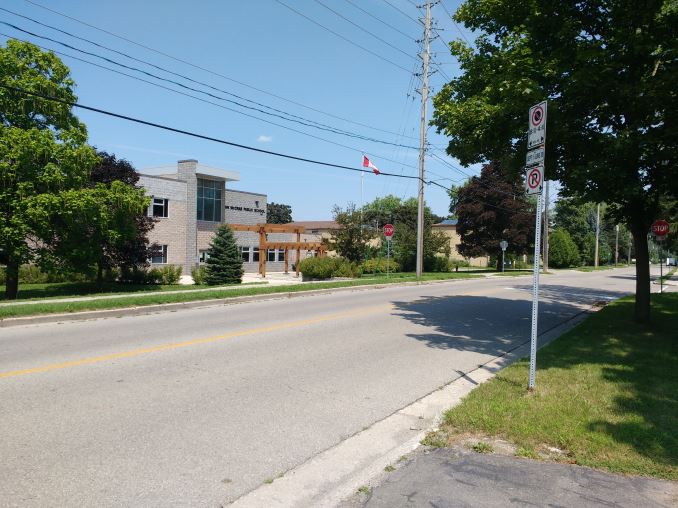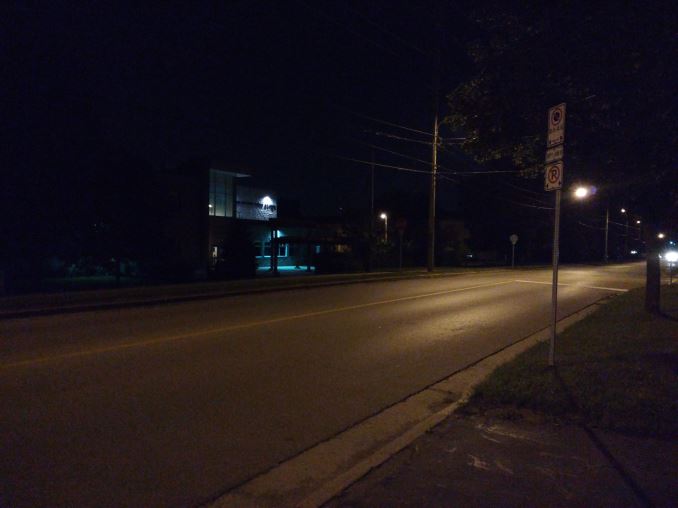The Moto G (2015) Review
by Brandon Chester on August 19, 2015 8:00 AM EST- Posted in
- Smartphones
- Mobile
Camera
One of the most notable improvements to the 2015 Moto G is its new rear-facing camera. The 2014 Moto G used Sony's IMX179, while the 2015 model adopts IMX214. The sensor size increases from 1/3.2" to 1/3.06" and the resolution increases from 8MP to 13MP. The aperture is also much wider, moving from F/2.4 to F/2.0, which can help offset the lower sensitivity of the smaller pixels. An overview of the Moto G's cameras can be found in the chart below.
| Camera Specifications | |||
| Moto G (2015) | |||
| Front Camera | 5MP (2560x1920) |
||
| Front Camera - Sensor | S5K5E2 (1.12 µm, 1/5") |
||
| Front Camera - Max Aperture | F/2.2 | ||
| Rear Camera | 13.0MP (4224x3400) |
||
| Rear Camera - Sensor | Sony IMX214 (1.12 µm, 1/3.06") |
||
| Rear Camera - Focal Length | 3.6mm (26mm eff) | ||
| Rear Camera - Max Aperture | F/2.0 | ||
While the Moto G lacks the voice coil motor from the Nexus 6 which is needed to enable OIS, the rest of the camera stack is effectively identical. The one difference on paper is the Moto G's shorter focal length which will give images a wider field of view.
Coincidentally, the move from IMX179 to IMX214 is the exact same change made between the Nexus 5 and Nexus 6. Whatever differences there are between the image quality of the 2015 Moto G and the Nexus 6 in good lighting rests primarily in the hands of their image signal processors. The Nexus 6 will obviously have a low light advantage due to its inclusion of OIS to lengthen shutter times, and we'll get to the low light differences after covering image quality with generous lighting.

In this daylight scene the Moto G performs very well. The exposure is very good, although I feel that it underexposed slightly while the Nexus 6 overexposed slightly. The Nexus 6 definitely has an edge when it comes to the sharpness of grass and foliage, as well as the preservation of textures such as the walls of the building and the pavement of the road. It's also worth noting that there's some lens distortion occurring on the Moto G which is causing color fringing along the white edges of the building windows, although at a normal viewing size it's barely noticeable. I think the Nexus 6 took an overall better photo, but only slightly better, with the Moto G doing a better job than any other mid-range device I've tested during the day.

Low light image quality is where things start to fall apart on the Moto G. While it's difficult to see in the small preview above, looking at the full size image reveals a great deal of color noise throughout the entire image, which doesn't exist on the Nexus 6. The Moto G took a 1/15s exposure, while the Nexus 6 was longer at 1/12s. 1/12s actually isn't very long for a device with OIS, and the difference in ISO value was not very large between the two devices either which means that Motorola's lacking quality has more to do with a simple lack of chroma noise reduction more than anything else. Chroma noise is by far the most distracting type of artifact in photos, and unfortunately it makes the Moto G unsuitable for photography in low light.
Video Quality
Video recording is a great test of a device's ISP as there's only a very short timespan to do processing on each frame that is captured. Since the 2015 Moto G and the Nexus 6 use the same image sensor this allows us to take a look at the differences in video quality between the ISPs in Snapdragon 410 and Snapdragon 805.
The Moto G records 1080p video at 30fps. Video is encoded with an average bitrate of 17Mbps using the H.264 high profile. For this comparison I limited the Nexus 6 to 1080p rather than UHD recording to make it an apples to apples comparison.
The most obvious advantage the Nexus 6 has is the stability of the video. While one might think this is due to the inclusion of OIS, the Nexus 6 isn't using the OIS for stabilization, and this is really just a case of superior EIS enabled by the superior ISP. As for the video quality itself, it's clear that the Nexus 6 is sharper across the frame and has greater detail on the various types of foliage in the area. The Nexus 6 also manages a better exposure, with the Moto G's video being too dark, with muted and just generally inaccurate colors. It appears that like the low light photo scene, the Moto G's video recording abilities are hampered by its ISP.
WiFi Performance
Like almost all of the low end and mid range devices I've tested recently, the Moto G ships with support for 802.11n on the 2.4GHz band. This single spatial stream implementation has a max link speed of 72Mbps.

The Moto G's WiFi speed is roughly the same as all other mid range devices. The Zenfone 2 is once again an exception to the rule, but I don't think anyone buying a device like the Moto G will have adopted an 802.11ac router at this point anyway due to cost reasons. I really hope we start seeing 5GHz support in mid range 802.11n phones though, rather than the ever increasingly crowded 2.4GHz band.






















90 Comments
View All Comments
Pissedoffyouth - Wednesday, August 19, 2015 - link
I was going to get this but got the Vodafone Smart Ultra 6 instead. If you're in Europe, that smokes this phone in every way for cheaper. £125 for 5.5 1080p screen, SD615, 2GB RAM/16GB.only £4 for unlock code on ebay too.
kspirit - Wednesday, August 19, 2015 - link
I love it when you guys post reviews this soon after the device comes out. <3spbx - Wednesday, August 19, 2015 - link
everyone forgot that this using vanilla android with fasr updates from motorola. I just hope that still remains even lenovo changed moto software dept.EnzoFX - Wednesday, August 19, 2015 - link
Yeah this is definitely a selling point to consider. Aside from the practicality of the device, the balances it strikes, those flip covers that are so functional and popular too haha, it's about the only thing in it's price range that promises an almost stock interface and prompt updates. It's like having Nexus device. This is why I consider Motorola. Shame about the display this time around though... wonder how bad it really is side-by-side.Moto1 - Wednesday, August 19, 2015 - link
NoMoto1 - Wednesday, August 19, 2015 - link
No fast updates! I have FIRST gen and ZERO updates. F@#k MotorolaOld_Fogie_Late_Bloomer - Thursday, August 20, 2015 - link
Unless you bought your phone non-carrier-locked, you're blaming the wrong entity. I'm not saying Motorola has been as expeditious as I would have liked, but if your phone is still on KitKat it's Cricket or whomever's fault.hans_ober - Wednesday, August 19, 2015 - link
Can you try charging it with a different (high amp) charger and report back? Most people aren't gonna use the charger included.Brandon Chester - Wednesday, August 19, 2015 - link
Actually it's likely that they will. Consumers buying these phones are not likely to have several chargers from previous devices laying around, and any that they do have would obviously be of a similar wattage because most OEMs ship these sub-5W with their non-flagship devices.hans_ober - Wednesday, August 19, 2015 - link
Ok you're right, but it would be really nice (and helpful) if you could update the review with a high amp charger, which would show an improvement one could gain from getting a better charger, since the phone is not the limiting factor.. Some other markets are shipping ~1A chargers.